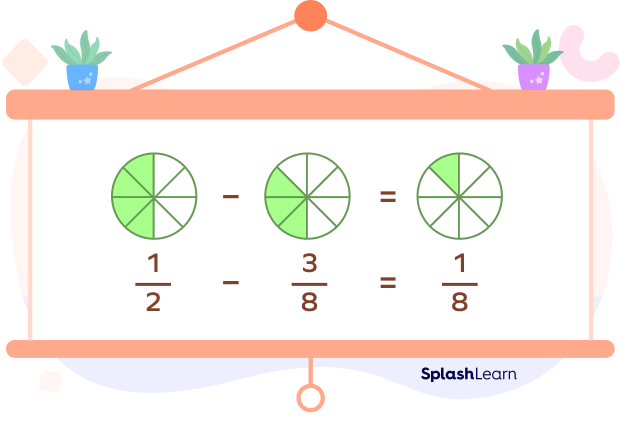- How to Subtract Fractions with Unlike Denominators
- Types of Fractions
- Subtracting Fractions with Unlike Denominators: Visual Model
- Solved Examples on Subtracting Fractions with Unlike Denominators
- Practice Problems on Subtracting Fractions with Unlike Denominators
- FAQs on Subtracting Fractions with Unlike Denominators
How to Subtract Fractions with Unlike Denominators
Subtracting fractions with unlike denominators is not a straightforward process as subtracting fractions having the same denominator.
Fractions represent the parts of a whole. A fraction has two parts. The number on the top of the line is called the numerator. It tells how many equal parts of the whole or collection are taken. The number below the line is called the denominator. It shows the total number of equal parts the whole is divided into or the total number of the same objects in a collection.
When the whole is divided into equal parts, the number of parts we take makes up a fraction.
If a cake is divided into eight equal pieces and each piece of cake represents $\frac{1}{8}$ of the whole cake. It is read as “one-eighth” or “1 by 8.”

Recommended Games
Types of Fractions
There are two types of fractions based on the value of the denominator.
- Like Fractions: Fractions with same denominators are known as like fractions or fractions with like denominators such as $\frac{1}{7}$ and $\frac{3}{7}; \frac{2}{5}$, and $\frac{4}{5}$.
- Unlike Fractions: Fractions with different denominators are known as unlike fractions or fractions with unlike denominators such as $\frac{1}{7}$ and $\frac{3}{8}; \frac{2}{9}$, and $\frac{4}{11}$.
The operations on like fractions is quite easy. Suppose we have to subtract $\frac{5}{6}$ from $\frac{4}{6}$. Since, the fractions are like, only the numerators will be subtracted and the denominator will remain the same, i.e., $\frac{5}{6}\;-\;\frac{4}{6} = \frac{1}{6}$
Visually, we represent it as follows:

When it comes to the fractions with unlike denominators, it is a little bit tricky. How can we subtract fractions with different denominators? Well, let’s learn how to subtract fractions with different denominators step by step using different methods.
Recommended Worksheets
Methods to Subtract Fractions with Unlike Denominators
Method I
This is the LCM method. The basic rule for subtracting fractions with different denominators is to make the denominators the same by finding the LCM of the two denominators.
Step 1: Find the least common multiple, i.e., LCM of the two denominators.
Let’s find $\frac{5}{6} \;-\; \frac{2}{9}$.
To find the LCM of 6 and 9, we write the prime factorization of 6 and 9 using exponents:
$6 = 2 \times 3$
$9 = 3 \times 3 = 3^{2}$
Here, the highest power of 2 is 2. The highest power of 3 is $3^{2}$.
Find the product of the factor terms that have the highest power.
LCM of 6 and $9 = 2 \times 3^{2} = 18$
Step 2: Convert both the fractions into like fractions by making the denominators same (i.e., by finding the equivalent fractions). In this example, we get
$\frac{5 \times 3} {6 \times 3} = \frac{15}{18}$ and $\frac{2 \times 2}{9 \times 2} = \frac{4}{18}$
Step 3: Subtract the numerators. The denominator stays the same.
$\frac{15}{18} \;-\ \frac{4}{18} = \frac{15 – 4}{18} = \frac{11}{18}$
Step 4: Convert the resultant fraction to its simplest form if the GCF of the numerator and denominator is not 1.
In this case, the GCF $(11, 18) = 1$. So, it is already in its simplest form.
Method II
Sometimes, there are cases when one denominator is the multiple of another denominator. Consider an example. Let’s subtract $\frac{12}{39}$ from $\frac{16}{13}$.
Multiplying big numbers can be time-consuming and lengthy. So, we will use the following steps:
Step 1: Since one denominator is multiple of the other, we can easily make the denominators the same. Multiply both the numerator and denominator of $\frac{16}{13}$ by 3.
$\frac{16 \times 3}{13 \times 3} = \frac{48}{39}$
Step 2: Subtracting the two fractions. In this example, we get
$\frac{48}{39} \;-\; \frac{12}{39} = \frac{36}{39}$
Step 3: Convert the fraction into the simplest form. In this example, we get
$\frac{36}{39} = \frac{12}{13}$
Method III
Let’s discuss the cross multiplication method. As the name suggests, we cross multiply as shown below.

The cross multiplication method works for all cases, but it is convenient to use when the denominators are small numbers.
Let’s subtract $\frac{5}{7}$ from $\frac{1}{2}$ by cross multiplication.
$\frac{5}{7} \;-\; \frac{1}{2} = \frac{(5 \times 2)\;-\;(7 \times 1)}{7 \times 2} = \frac{10\;-\;7}{14} = \frac{3}{14}$
Subtracting Mixed Fractions with Unlike Denominators
Mixed numbers or mixed fractions have a whole number part and a fractional part. Some examples of mixed fractions with unlike denominators are $2\frac{1}{6}$ and $5\frac{2}{5}$. Let’s understand how to subtract mixed numbers with unlike denominators by converting them into improper fractions. Subtracting improper fractions follows the same methods that we discussed earlier.
Suppose we have to subtract $2\frac{1}{6}$ from $5\frac{2}{5}$. We use the steps given below:
Step 1: Convert the mixed numbers into improper fractions. In this case, we get
$2\frac{1}{6} = \frac{12 + 1}{6} = \frac{13}{6}$ and $5\frac{2}{5} = \frac{25 + 2}{5} = \frac{27}{5}$.
Step 2: Find the LCM of the denominators and make the denominators same. In this case, LCM $(5, 6) = 30$
$\frac{13 \times 5}{6 \times 5} = \frac{65}{30}$ and $\frac{27 \times 6}{5 \times 6} = \frac{162}{30}$
Step 3: Subtract both the fractions. In this case, we can write all the steps together as
$5\frac{2}{5} \;-\; 2\frac{1}{6} = \frac{27}{5}\;-\; \frac{13}{6} = \frac{162}{30} \;-\; \frac{65}{30} = \frac{162\;-\;65}{30} = \frac{97}{30}$
Step 4: Convert into a mixed number. In this case, we get $\frac{97}{30} = 3\frac{7}{10}$.
Subtracting Fractions with Unlike Denominators: Visual Model
Consider one example. Suppose we have to subtract $\frac{3}{8}$ from $\frac{1}{2}$.
We can represent this subtraction visually as follows. LCM of 2 and 8 is 8.
So, both the circles are divided into 8 equal parts.
$\frac{1}{2} = \frac{4}{8}$
Thus, to represent $\frac{1}{2}$, we can see that 4 parts out of 8 equal parts are shaded.
To represent $\frac{3}{8}$ of a circle, 3 parts out of 8 parts are shaded.
If we take away these three parts from the first circle, only 1 shaded part remains, which represents $\frac{1}{8}$.

Conclusion
In this article, we learned about the subtraction of fractions with unlike denominators. Let’s solve some examples for better understanding.
Solved Examples on Subtracting Fractions with Unlike Denominators
1. Subtract $\frac{3}{4}$ from $\frac{5}{6}$ using the LCM method.
Solution:
Prime factorization of denominators 4 and 6:
$4 = 2^{2}$ and $6 = 2\times3$
LCM(4, 6) = Product of factor terms with highest powers $= 2^{2} \times 3 = 12$
$\frac{3 \times 3}{4 \times 3} = \frac{9}{12}$ and $\frac{5 \times 2}{6 \times 2} = \frac{10}{12}$
$\frac{5}{6}\;-\;\frac{3}{4} = \frac{10}{12}\;-\;\frac{9}{12} = \frac{10 \;-\; 9}{12} =\frac{1}{12}$
2. Find the difference: $\frac{1}{5}\;-\;\frac{1}{7}$.
Solution: We will use the cross multiplication method here.
$7 \times 1 = 7$ and $5 \times 1 = 5$. Also, $5 \times 7 = 35$
So, $\frac{1}{5}\;-\;\frac{1}{7}=\frac{7 \;-\; 5}{35} = \frac{2}{35}$
3. Jack has $\frac{4}{5}$ pounds of a papaya. If he gives $\frac{1}{3}$ pounds to Lucy, what fraction of papaya is left with Jack?
Solution: Fraction of papaya with Jack $= \frac{4}{5}$
Fraction of papaya he gave to Lucy $= \frac{1}{3}$
Fraction of papaya left with Jack $= \frac{4}{5} \;-\; \frac{1}{3}$
We will use the cross multiplication here
$\frac{4}{5}\;-\;\frac{1}{3} = \frac{12 \;-\; 5}{15} = \frac{7}{15}$
Fraction of papaya left with Jack $= \frac{7}{15}$
4. Find $\frac{3}{4}\;-\;\frac{1}{5}$.
Solution:
We have to find the difference $\frac{3}{4}\;-\;\frac{1}{5}$.
Using the cross multiplication method, we get
$\frac{15 – 4}{20} = \frac{11}{20}$
$\frac{3}{4}\;-\;\frac{1}{5} = \frac{11}{20}$
5. Jack jumped $3\frac{1}{7}$ m in a long jump competition. Shane jumped $1\frac{2}{9}$ m. By how many meters did Jack jump longer?
Solution: Distance jumped by Jack $= 3\frac{1}{7}$ m
Distance jumped by Shane $= 1\frac{2}{9}$ m
Difference $= 3\frac{1}{7}\;-\;1\frac{2}{9}$
$3\frac{1}{7}\;-\;1\frac{2}{9} = 2\frac{2}{7}\;-\;\frac{11}{9} = \frac{198\;-\; 77}{63} = \frac{121}{63}$
So, Jack jumped longer than Shane by $1\frac{58}{63}$ m.
Practice Problems on Subtracting Fractions with Unlike Denominators
Subtract Fractions with Unlike Denominators – Definition with Examples
Find the difference: $\frac{7}{5}\;-\;\frac{5}{6}\;-\;\frac{1}{3}$.
LCM of 5, 6, and $3 = 30$
$\frac{7}{5}\;-\;\frac{5}{6}\;-\;\frac{1}{3} = \frac{42}{30}\;-\;\frac{25}{30}\;-\;\frac{10}{30} = \frac{42\;-\;25\;-\;10}{30} = \frac{7}{30}$
What will be denominator of the resultant when $\frac{23}{49}$ is subtracted from $\frac{11}{7}$?
Since 49 is a multiple of 7, so the denominator of the resultant fraction will be 49.
$\frac{11 \times 7}{7 \times 7} = \frac{77}{49}$
$\frac{77}{49}\;-\; \frac{23}{49} = \frac{54}{49}$
The distance of Alex's home to his school is $\frac{3}{8}$ miles. If he has already covered $\frac{1}{4}$ miles distance on foot, how much more does he need to cover to reach school?
Distance he needs to cover more $= \frac{3}{8}\;-\;\frac{1}{4}$
LCM of 8 and $4 = 8$
$\frac{3}{8}\;-\;\frac{1}{4} = \frac{3}{8}\;-\;\frac{2}{8} =\frac{1}{8}$ miles
A recipe needs $\frac{3}{4}$ teaspoon sugar and $\frac{1}{5}$ teaspoon salt. How much more sugar than salt does the recipe need?
Amount of sugar $= \frac{3}{4}$ teaspoon and amount of salt $= \frac{1}{5}$ teaspoon
Difference $= \frac{3}{4}\;-\;\frac{1}{5} = \frac{15\;-\;4}{20} = \frac{11}{20}$
FAQs on Subtracting Fractions with Unlike Denominators
On subtracting two fractions with unlike denominators, do we always get a proper fraction?
No, we can get an improper fraction also by subtracting the fractions with unlike denominators. If we subtract $1\frac{1}{7}$ from $3\frac{1}{2}$, we get $2\frac{5}{14}$.
How do you subtract a fraction from 1?
For subtracting a fraction from 1, we first convert 1 into bb where b is the denominator of the fraction we are subtracting . Example: $1\;-\; \frac{2}{7} = \frac{7}{7} \;-\; \frac{2}{7} = \frac{5}{7}$
What is the difference between subtracting unlike fractions and subtracting like fractions?
For subtracting unlike fractions, we generally use the cross multiplication method or LCM method and convert the unlike fractions to like fractions and then subtract the numerator. When subtracting like fractions, we just simply subtract the numerators.
Can the subtraction of fractions with unlike denominators give 0?
Yes, we can get the result as 0 when two equivalent fractions are subtracted. For example: $\frac{2}{6} \;-\; \frac{1}{3} = \frac{1}{3} \;-\; \frac{1}{3} = 0$
How to add fractions with different denominators?
We can add fractions with different denominators by using the methods we used for subtraction. The steps to adding fractions with unlike denominators are pretty similar. We will just use a plus sign instead of minus.




































